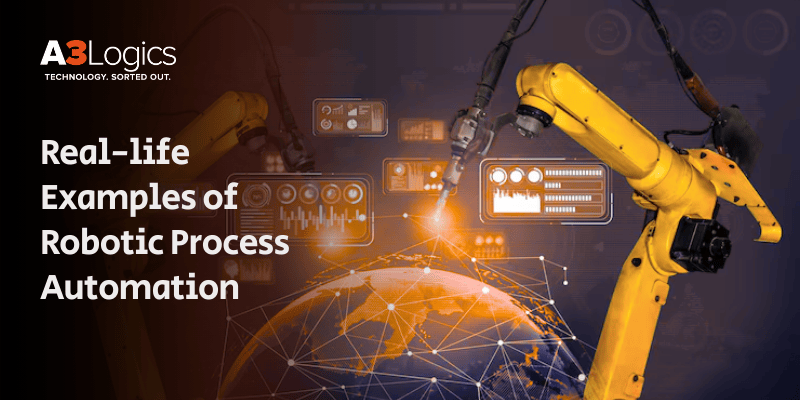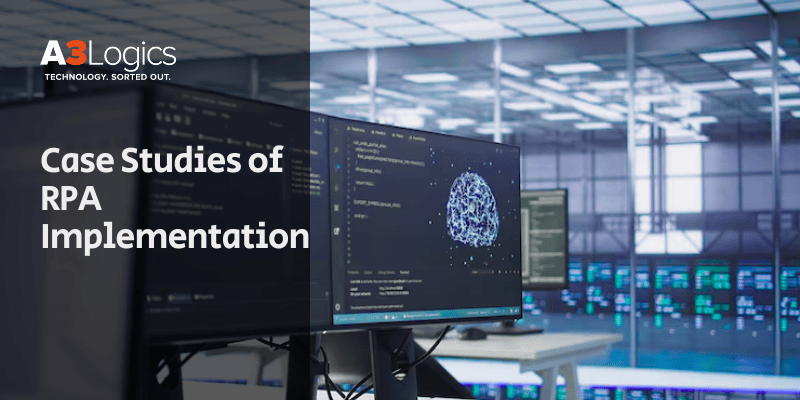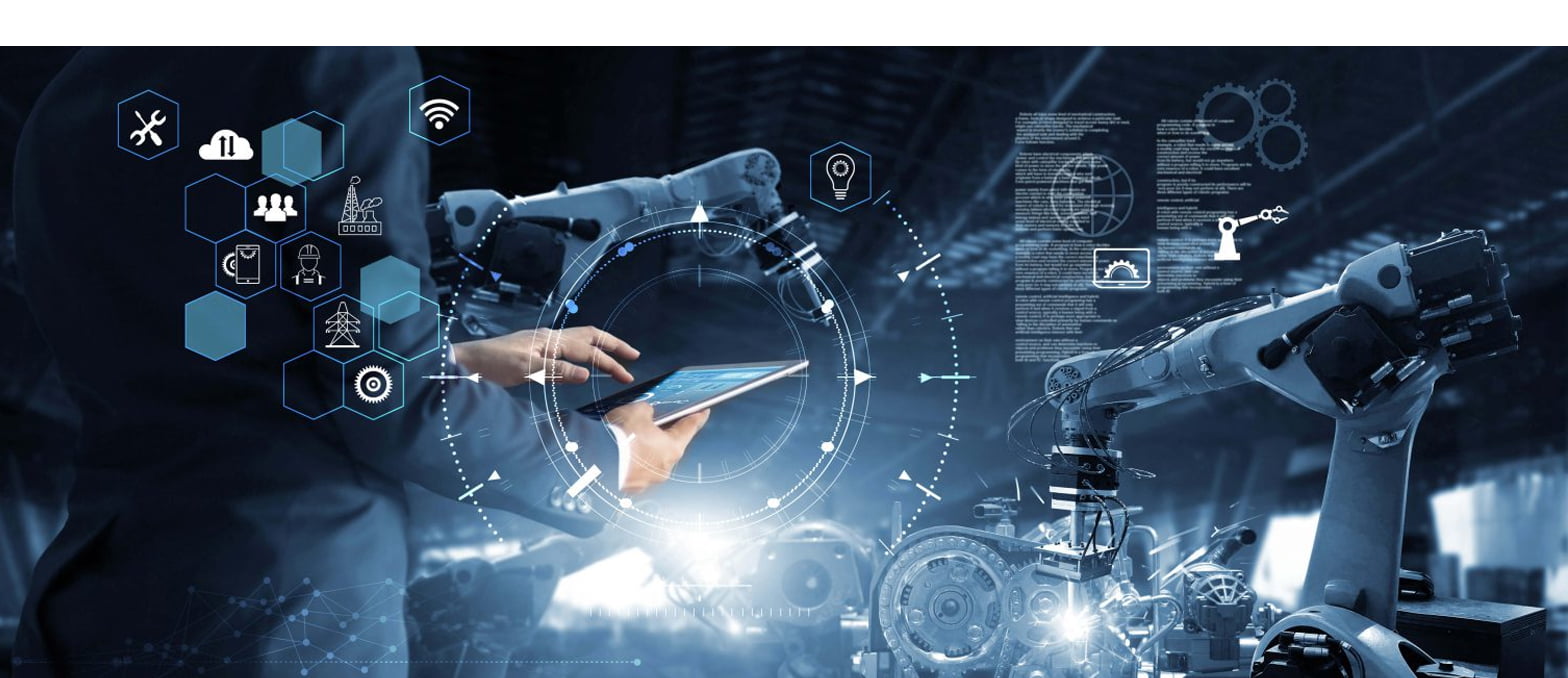Around 80% of executives believe that automation is crucial for businesses. Numerous business verticals have a wide range of repetitive tasks, which take up time and reduce workforce efficiency. Without automation, these tasks lead to decreased employee productivity. Real-life examples of robotic process automation clearly demonstrate how automating such processes can significantly enhance performance across industries.

One of the key ways of overcoming this challenge is to streamline the business through robotic process automation. Robotic process automation was valued at $3.8 billion in 2024 and is expected to grow at a CAGR of 43.9% till 2030.
Robotic process automation can help revolutionize productivity and boost efficiency for organizations. It helps increase productivity and save costs across various sectors like healthcare, finance, retail, manufacturing, etc. In 2024 itself, around 52% of financial organizations were able to save US$100,000 through automation.
Numerous real-life examples of robotic process automation help to handle high-volume, repetitive, and rule-based tasks. Irrespective of the industry you are in, integrating RPA bots can be a great addition for your business.
Table of Contents
What is Robotic Process Automation?
Robotic Process Automation (RPA) refers to the technology that uses boys or software bots to automate repetitive, rules-based, and structured tasks that were initially done manually. RPA can be extremely beneficial for performing a wide range of tasks such as invoice processing, data entry, report generation and other routine business processes.
Key features for RPA involves a wide range of things, such as the following:
- Scalability
- Non-intrusive deployment
- Integration with the existing system
Integration of RPA tools can help mimic human actions like typing, clicking and reading data from different screens. Therefore, it can perform a wide range of tasks which follow as per specific rules, and also require human judgement. The real-life examples of RPA ensures across various industries determines how it simplifies businesses.
Some of the key tasks suitable for RPA examples through the structures and repetitive format include copying data between systems, email processing, and form filling.
Robotic process automation can reduce repetitive tasks as bots will automate them. Therefore, businesses can use this technology to streamline operations and provide high-value work. Thus, some of the key benefits of RPA integration include the following:
- Improves efficiency
- Saved extra costs
- Reduces human errors
Case Studies of RPA Implementation

Various real-life examples of RPA implementation have determined its success for businesses. Therefore, companies of all sizes can understand the process and integrate RPA into their business scope.
Here are the top real-life examples of robotic process automation implementation:
1. IBM

Numerous case studies on IBM demonstrate the benefits of RPA for businesses. One of the most prominent real-life examples of RPA implementation of IBM has been the System of Credit Unions of Brazil, Primanti Brothers and New Mexico Mutual.
Some of the top real-world examples of RPA robotic process automation are as follows:
- Sicoob: Using IBM’s RPA technology, Sicoob reduced the processing time by 80%, increasing employee productivity. Automating the tasks paved the way for the business’s 10-20% cost savings.
- Primanti Brothers: On the other hand, leveraging IBM’s RPA technology, Primanti Brothers automated repetitive tasks, saving around 2,000 manual work hours annually. The technology helped the business automate the task for eight regional managers, and generate 40 reports weekly. This contributed to the company achieving 100% ROI within three months.
- New Mexico Mutual: New Mexico Mutual’s RPA bot implementation has played an essential role in boosting employee productivity. Earlier, the policy renewal policy took up to 20 minutes. However, now the bot makes it possible within 5 minutes. Till now, the software has issued 700+ renewals and counting.
2. UiPath’s case studies

The agentic automation of UiPath has helped numerous businesses across different business verticals to streamline and automate tasks. The integration of RPA technology helped UiPath’s clients achieve accuracy and efficiency in business processes. Below are some of the top case studies of UiPath’s agentic automation as real-life RPA examples:
- Sappi: Sappi is the global provider of woodfire-based renewable materials. There are numerous departments in Sappi that have a scope of automation, from administrative to financial functions, HR and more. To date, Sappi has automated 132 processes and saved 13,000 hours in Europe. This highlights the effort of the team’s RPA for streamlined digital transformation. This brought a higher success rate, improved accuracy, time savings and better business resilience for global operations.
- The Arnott’s Group: The Arnott’s Group is the custodian for some of Australia’s most recognized food brands. There are around 4,000 people employed with manufacturing operations across Asia Pacific. The Arnott Group adopted a structured approach for enterprise automation to optimize operations and drive business growth opportunities. Through a focus on planning and prioritizing, automation now helps the business, with 75% of manual orders now being processed digitally. Through UiPath’s automation, the company has a 99% week-on-week sustained robotic success with 10 average months to ROI.
- Xerox: Xerox is one of the oldest business models for over a century, helping businesses enhance their workflow for better performance, transformation, and agility. Xerox has now shifted to solving business problems through digitization and innovative technologies. Xerox and UiPath collaborated with some high-value and complex use cases. In the newer business model, around 600 robots were deployed with 6 million quarterly transactions. RPA integration eventually helped with the customer supply replenishment process and handling Service Desk integration tasks to improve engagement and customer experience. This is one of the best examples of RPA usage for adopting modern technology.
3. Nividous’

Nividious showcased one of the most streamlined real-life examples of RPA solutions for one of their specialty healthcare clients focusing on cancer and cardiac care. Through RPA integration, Nividious helped with patient data extraction, patient claim submission and patient data review.
The main problem was in streamlining the back office operations across a disconnected system because of the unstructured and unclear guidelines.
In addition, around 10 employees from the organization have to manually review and extract patient data, which makes the process prone to errors. It also leads to delays in claims and payments.
To resolve the problem, Nividious established RPA bots with cognitive abilities. These RPA bots helped with data review, data extraction, and claim submission tasks for automation. The bots helped streamline end-to-end operations. Eventually, the claim submission process timeline was reduced by 70% within two weeks. Through automation, repetitive tasks were automated, leading to an 80% reduction in manual work and a 65% improvement in productivity. RPA integration also helped to reduce the operational cost by 45%.
4. American Express: Automating Card Collection

One of the most prominent real-life examples of Robotic Process Automation is automating card collection by American Express. American Express offers numerous automation solutions- HighRadius, Versapay and Boost Payment Solutions. HighRadius is the AI-powered, completely integrated account receivables which is crucial for the business to manage cash flow. Versapay follows a collaborative approach in American Express to improve cash flow and customer experience.
American Express partnered with Boost Payment Solutions to launch Boost Intercept for US businesses. This is the Straight-Through Processing patented technology that automated numerous processes like virtual card payments and addressed challenges involved with manual handling.
Boost Intercept eliminates the risk of manual tasks while automating virtual card payments with end-to-end solutions. The shorter payment cycle through automation improves cash flow and offers faster fund settlement. The integration of Boost Payment Solutions also helped with payment automation, saving around 9.9 hours per week, leading to 500 hours manually.
It is also expected that automation solutions by American Express will also bring about an adoption of virtual cards. By the end of 2025, around 52% of US commercial card spending will be done via virtual cards. The US businesses also admitted that automation saves their finance team around 36% of the time.
5. Coca-Cola Bottling Company

One of the most successful real-life examples of RPA integration is that of Coca-Cola. Coca Cola integrated RPA technology in the accounts payable department. The main aim was to automate numerous tasks, like
- Invoice verification
- Account reconciliation
- Payment processing
Through RPA implementation, Coca-Cola reduced processing times while optimizing supplier payment management processes. Automating accounts payable reduced employees’ workload, allowing them to focus on other crucial tasks like financial analysis and strategic decision-making. RPA integration sped up payment processing while improving communication and reducing waiting times. This brought better satisfaction and helped to strengthen relationships with suppliers.
Coca-Cola integrated RPA technology with legacy systems, paving the way for faster and efficient implementation. As one of the finest examples of RPA integration, it also brought about scalability and growth, ensuring automation of other processes too within the company.
6. Deutsche Bank

Deutsche Bank launched the Robotic Process Automation commercialization process. It introduced a multibank Data Processing and Reconciliation Solution developed by the Blue Water Fintech lab. Through automated reconciliation, the tool aims to reduce human intervention and prevent manual errors.
As one of the prime real-life examples of robotic process automation in the initial stages, the pilot program shows that 60-80 hours of manual work can be saved every month. The RPA integration ensures handling tens of thousands of financial data in the same time frame. Therefore, it helps to shorten the reconciliation time from 2-3 days to one hour. While reducing the time frame, it maintains complete accuracy to prevent data problems caused due to manual entry errors.
Through RPA integration, Deutsche Bank aims to create a win-win situation for banks and enterprises through newer technology. As one of the modern examples of RPA automation paves the way for successful digital transformation while enhancing efficiency across corporate operations.
7. Fortune 100 Bank

A Fortune 100 Bank used Robotic Process Automation to streamline its high-volume, repetitive operations across various departments. By integrating this technology, the bank reassigned 50 full-time employees to more strategic tasks, improving their productivity. Fortune 100 Bank brought about one of the easiest real-world examples of RPA robotic process automation.
The robotic process automation services also played an important role in complying with regulatory guidelines across high-risk and audit-sensitive processes. The process accelerated turnaround times for core business operations like account reconciliation and loan processing. The rule-based automated tasks also help to strengthen bank resilience for improving accuracy through RPA in enterprise banking.
8. NASA

One of the prime real-life examples of Robotic Process Automation (RPA) is by NASA. NASA integrated RPA to improve operational efficiency and lower manual workloads. The NASA Shared Services Center (NSSC) initiated the RPA journey in 2016 and deployed pilot bots mid-2017.
In 2018, NSSC launched Intelligent Automation Services to automate routine and repetitive tasks. The introduction of bots in streamlining the processes. The bots helped to improve processing times for tasks that require extensive manual effort. Furthermore, it also decreases backlogs while providing high-value work to expand services.
The NSSC is the hub of automation for NASA. The NSSC IAS team is responsible for developing around 95% of the NEAS (NASA Enterprise Automation Services) portfolio. This is helping to reduce extra costs while improving efficiency.
Tips for a Successful RPA Journey
A successful RPA journey is highly crucial in ensuring the growth of the business in the long run. Stakeholder management, execution, and the right tools can help you understand the key tips for a successful RPA journey. Furthermore, you should also look for real-life examples of RPA, as they can help you understand the process so you can further implement it.
Some of the key tips to follow for a successful RPA journey are as follows:
Start with a pilot project
For a successful RPA integration, start with a pilot project. The pilot project can be for a specific duration where the entire team comes together to understand how automation works. The pilot project involving the software can be for a month. This can give your team clarity on what processes can be automated and how they can work together to achieve those goals. The examples of RPA automation suggest that Starting small provides low risk and can also help you test the effectiveness of the RPA tool.
Involve business and IT teams
During the pilot project, it is advisable to include your business and IT teams. Involving all the teams can provide clarity on what processes can be automated. Involving stakeholders and IT teams during the pilot project helps to proper alignment and support within the team. You may also include end-users to ensure everyone is well aligned about the project and working towards achieving their goals.
Set clear KPIs
Almost all real-life examples of RPA have shown that successful RPA processes are the ones that have clear goals. Similarly, you have to showcase that your business has clear goals that you aim to achieve via RPA implementation. For this reason, it is highly crucial to set clear KPIs. Define clear goals like processing time, accuracy rate, and cost savings to track RPA performance and boost ROI for the business.
Plan for scalability and maintenance
Integrate an RPA tool into your business that can help you achieve success. As you include more business functions and programs, the workload on the software will increase. Therefore, it is crucial to choose a scalable and easy-to-maintain tool in situations like these. This can be beneficial in the future for driving the growth of business processes.
Benefits Realized from RPA in Real Life
RPA Integration has a wide range of benefits. The real-life examples of RPA have brought a rapid return on investments. Banks, hospitality, healthcare sectors, and others have been able to integrate RPA to boost returns while bringing about streamlined tasks. Below are some of the notable benefits of RPA:
1. Quantitative Benefits
The Robotic Process Automation real world examples show how the integration brings immediate and measurable gains to lower operational costs, reducing errors and saving time. The automated bot helps to increase the productivity of employees while improving accuracy. It can free up the resources with proper processing time and drive strategic initiatives for further growth.
2. Qualitative Benefits
RPA can help improve the work environment’s quality and service delivery. It easily handles repetitive and mundane tasks, while human employees can focus on higher-value and more complicated tasks. As customers get faster responses, there will be less service disruptions. Furthermore, the real-life examples of RPA also drive scalability to ensure proper adjustment.
3. Optimized Resource Utilization
Robotic process optimization allows businesses to allocate human resources effectively. As RPA tools handle repetitive tasks, employees can focus on customer engagement and innovation. This ensures that business operations are aligned with the goals for improving efficiency.
4. Better Data Quality and Analytics
RPA reduces human error and plays a vital role in improving data quality in data entry and processing. The bots will follow preset rules to drive consistency and accuracy. The examples of RPA in everyday life also assists with forecasting and compliance reporting for better strategic decision-making. Therefore, the businesses can then take accurate decisions through real-time insights.
5. Fewer Staffing Challenges
The Robotic Process Automation: real world examples highlighted how it can help to combat staffing challenges. RPA becomes your virtual workforce that allows you to scale the business up and down accurately. Therefore, your business will not have to rely on temporary staffing initially, thereby removing pressure from the HR departments. This can play an essential role in better organization.
6. Versatility Across Industries and Processes
The adaptability has helped in the success of real-life examples of RPA. It can be easily integrated across healthcare, financial, retail, manufacturing and a wide range of other industries. Furthermore, it can also support various processes like inventory management, compliance checks, customer service and invoice processing. The versatility caters to digital transformation across every sector.
Key Criteria for RPA Implementation
RPA implementation can drive significant benefits when it is applied to structured data. It is essential to be mindful of the various key criteria for RPA implementation to drive business success.
The real-life examples of RPA have emphasized the importance of accepting and adapting to these key criteria for driving business success. Some of the key criteria businesses must keep in mind for RPA implementation are as follows:
Rule-based
RPA can play an important role in automating repetitive and rule-based tasks, which means that it follows a specific set of rules and instructions. Rule-based products are predictable. Therefore, these do not require any manual judgment. Most of the examples of robotic process automation used rule-based to simplify complex tasks.
For example, you may have a specific set of rules for identifying anomalies or fraud in your system. The RPA integrated with your system will identify or detect fraud based on those preset criteria. This automates the tasks by reducing manual efforts. Furthermore, it reduces the chances of manual errors.
High volume
When you’re doing high-volume tasks manually, management can become extremely difficult. Instead, high-volume and time-consuming tasks can be easily automated using RPA tools. These high volume tasks can be easily handled by the RPa tools accurately.
For example, real-life examples of RPA in the finance sector have used RPA for fraud detection and saving data. The RPA tools can reconcile data between multiple digital systems or accounts in the finance sector. This provides businesses the benefit of maintaining accurate balance information. As a result, the risk of any data discrepancy in calculation is significantly reduced.
Repetitive
Repetitive tasks require proper integration and automation. RPA tools can be essential in automating repetitive tasks and ensuring they are done sooner. The routined and standardized processes of RPA help to ensure that even the repetitive tasks are done as per a specific workflow.
The examples of RPA in everyday life suggest that the tools can streamline numerous repetitive tasks such as collecting and managing client information, creating user accounts and then setting up specific goals for businesses. It will automatically transfer the details and automate all crucial, repetitive business functions. Therefore, your team will not have to indulge in these repetitive tasks which can eventually help to boost productivity of the team.
Low exception rate
RPA is a highly ideal process for low exception rate tasks. It drives higher precision and accuracy. This is because the robots will help to reduce manual errors. As a result, the tasks won’t have any problems like inaccurate number input, overlooked details, or miscalculations.
The low exception criteria fit perfectly for the real-life examples of Robotic Process Automation in the finance and healthcare sector. It checks whether specific transactions and business criteria are met or not. Automating, collecting and generating the reports with complete accuracy becomes easier. This can help create tax audits and financial report preparation.
Challenges and Considerations
Before learning and adopting from the real-life examples of Robotic Process Automation, it is essential to understand the challenges and considerations too. Below are some of the key ones to consider:
Integration with legacy systems
RPA integration with legacy systems paves the way for complexity due to a lack of modern features. Therefore, integration to counter cyberattacks can be challenging because of outdated security protocols. Furthermore, incompatible data formation can also lead to data loss.
Need for cognitive capabilities for unstructured data
The real-life examples of RPA show the usage of simple, structured data. However, handling unstructured data can be complex, leading to cognitive challenges, especially in handling unstructured data. Moreover, the cognitive capabilities for unstructured data can also be biased for the data upon which it is trained. This can sometimes lead to incorrect results.
Change management and employee adaptation
Change management and employee adaptation can be a major challenge as many employees often fear automation would lead to their job loss. While the real-life examples of Robotic Process Automation are a clear example of how helpful it is, the uncertainty still lingers. Educating your employees about RPa can help to overcome the resistance. Moreover, successful RPA implementation requires training the employees and integrating a strategic approach for supervisory or analytical roles.
The Future of RPA: Trends & Predictions 2025
The future of RPA will pave the way for the success of businesses, considering the significant advancements. Implementing real-life examples of RPA will make it further easier to drive business success.
Below are some of the key trends and predictions that will shape the future of RPA in 2025 and beyond:
Hyper Automation Becomes Mainstream
Hyperautomation with advanced technologies like process mining, machine learning, and AI will likely become a mainstream business strategy. Businesses will integrate the learnings from real-life examples of RPA to provide a holistic digital transformation. With hyper-automation becoming mainstream, businesses will adopt scalability, agility, and efficiency to stay ahead in the competitive landscape.
AI-Driven RPA Takes Center Stage
AI-driven RPA will revolutionize automation. This can be helpful for simplifying unstructured data and also dive in for context-based decisions. As a result, in the future, AI-driven RPA will be able to easily handle complex workflows like natural language processing, intelligent document processing, and predictive analysis.
Industry-Specific and Vertical Solutions
With developments in RPA, it is becoming very industry-specific. Various sectors are adopting RPA specific to their niche, like retail, logistics, manufacturing, and more. The targeted solutions cater to driving regulatory compliance and operational needs. This powers faster implementation while driving impactful results.
Robot as a Service (RaaS) and Cloud-Based Automation
Businesses are gradually adopting Robot as a Service technology to drive accessibility and foster cost-effective decisions. Businesses can now easily integrate the bots on demand without heavy infrastructure investment. The cloud-based automation also offers better security, continuous updates and increased security. Various examples of robotic process automation today are adopting RaaS and cloud-based automation to streamline their business operations.
RPA Market Growth and Investment
The global RPA market is growing at a rapid scale. The digital-first initiatives will bring about operational efficiency. Therefore, investment in RPA technologies is also increasing across various industries. The investments by venture capitalists, government funds, and enterprise spending are also enabling the automation system to expand.
Read more : RPA Statistics
Enhanced Integration and Lifecycle Management
The upcoming RPA tools will have better integration with APIs, third-party applications and enterprise systems. The lifecycle management can be brought through exclusive monitoring, maintenance, design and deployment. It will offer streamlined solutions to fit the changing business needs.
Human-Robot Collaboration and Workforce Transformation
The real-life examples of RPA have shown that these tools are here to improve efficiency. Human collaboration with these digital bots will ensure the work is done faster. While the bots handle repetitive tasks, human employees can focus on the core components of the business. This streamlined relationship will help with better reskilling and providing the best growth opportunities.
Data-driven Automation and Smart Analytics
RPA tools will use data and analytics for optimizing business performance and decision-making. The bots can analyze the structured data. This data can be used for predicting outcomes and identifying bottlenecks. Furthermore, improvements can also be recommended. Therefore, automation can prove to be a better option for business growth, helping to make better decisions.
Overcoming Implementation Challenges
The evolution in RPA technology will also help to overcome the challenges. These RPA implementation hurdles will help to overcome issues such as change management, process selection, and even complexity in choosing tools and governance frameworks. Automation deployment in business can speed up all necessary tasks.
Conclusion
Robotic process automation has played an essential role in the growth of companies across different industries. This technology has helped to streamline numerous tasks, offering benefits in multiple ways. The real-life examples of RPA are a testament that it can help your business achieve its goals in no time.
Around two-thirds of industry leaders believe that automation is crucial for attracting the attention of newer customers and retaining the older ones. Therefore, it is time to automate the business functions and drive sustainability, streamlined operations, and growth. If you want RPA for your business too, you need to partner with a RPA development company who can bring the necessary changes for your business.









